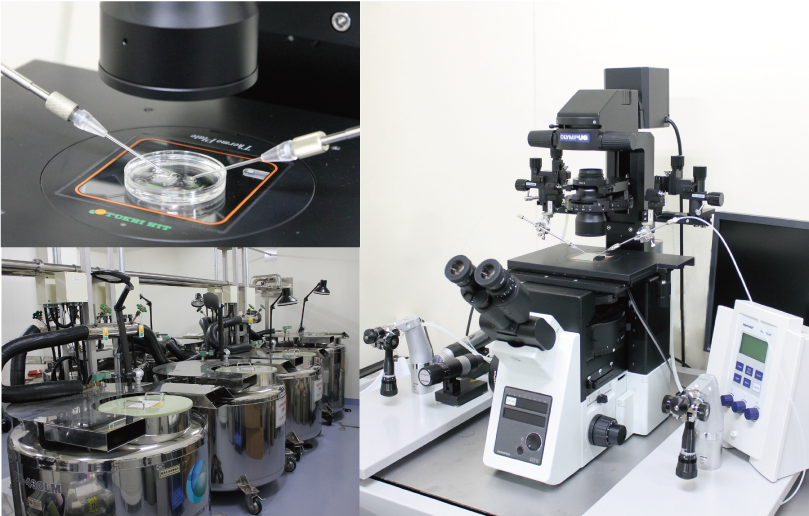Animal Resource Laboratory
On the basis of reproductive engineering technologies (induction of superovulation, in vitro fertilization, embryo transfer, cryopreservation of embryos/ova/sperm),
we are establishing genetically modified mice and rats and are also managing their strains by cryopreservation.
We have been working on the development and improvement of more efficient genetic modification and cryopreservation technologies and are developing new animal models to
contribute to the life science and biomedical fields.
【Activities】
- Cryopreservation of embryos, ova and sperm
- Microbiological cleaning (SPF/Germ-free)
- Generation of genetically modified animals
- Scheduled mouse production and speed congenic
- Rescue of infertile mice
- Development and improvement of technologies related to reproductive engineering technology
- Education and training research using various reproductive engineering technologies
※References
- Generation of hypoimmunogenic T cells from genetically engineered allogeneic human induced pluripotent stem cells.
Wang B, Iriguchi S, Waseda M, Ueda N, Ueda T, Xu H, Minagawa A, Ishikawa A, Yano H, Ishi T, Ito R, Goto M, Takahashi R, Uemura Y, Hotta A, Kaneko S.
Nature Biomedical Engineering. 2021 May;5(5):429-440.
- DNAM-1 regulates Foxp3 expression in regulatory T cells by interfering with TIGIT under inflammatory conditions.
Sato K, Yamashita-Kanemaru Y, Abe F, Murata R, Nakamura-Shinya Y, Kanemaru K, Muratani M, Veillette A, Goto M, Ito M, Shibuya A, Shibuya K.
Proc Natl Acad Sci USA. 2021 May 25;118(21):e2021309118.
- Host-microbe cross-talk governs amino acid chirality to regulate survival and differentiation of B cells.
Suzuki M, Sujino T, Chiba S, Harada Y, Goto M, Takahashi R, Mita M, Hamase K, Kanai T, Ito M, Waldor MK, Yasui M, Sasabe J.
Sci Adv. 2021 Mar 3;7(10):eabd6480.
- Efficient production of immunodeficient non-obese diabetic/Shi-scid IL2rcnull mice via the superovulation technique using inhibin antiserum and gonadotropin.
Goto M, Takeo T, Takahashi R, Nakagata N.
Laboratory Animals. 2021 Feb;55(1):13-20.
- Behavioral and electrophysiological evidence for a neuroprotective role of aquaporin-4 in the 5xFAD transgenic mice model.
Abe Y, Ikegawa N, Yoshida K, Muramatsu K, Hattori S, Kawai K, Murakami M, Tanaka T, Goda W, Goto M, Yamamoto T, Hashimoto T, Yamada K, Shibata T, Misawa H, Mimura M, Tanaka KF, Miyakawa T, Iwatsubo T, Hata JI, Niikura T, Yasui M.
Acta Neuropathol Commun. 2020 May 12;8(1):67.
- Ectopic Expression Induces Abnormal Somatodendritic Distribution of Tau in the Mouse Brain.
Kubo A, Ueda S, Yamane A, Wada-Kakuda S, Narita M, Matsuyama M, Nomori A, Takashima A, Kato T, Onodera O, Goto M, Ito M, Tomiyama T, Mori H, Murayama S, Ihara Y, Misonou H, Miyasaka T.
J Neurosci. 2019 Aug 21;39(34):6781-6797.
- Development of blastocyst complementation technology without contributions to gametes and the brain.
Hashimoto H, Eto T, Yamamoto M, Yagoto M, Goto M, Kagawa T, Kojima K, Kawai K, Akimoto T, Takahashi R.
Exp Anim. 2019 Aug 14;68(3):361-370.
- Novel reporter and deleter mouse strains generated using VCre/VloxP and SCre/SloxP systems, and their system specificity in mice.
Yoshimura Y, Ida-Tanaka M, Hiramaki T, Goto M, Kamisako T, Eto T, Yagoto M, Kawai K, Takahashi T, Nakayama M, Ito M.
Transgenic Res. 2018 Apr;27(2):193-201.
- Establishment of Immunodeficient Retinal Degeneration Model Mice and Functional Maturation of Human ESC-Derived Retinal Sheets after Transplantation.
Iraha S, Tu HY, Yamasaki S, Kagawa T, Goto M, Takahashi R, Watanabe T, Sugita S, Yonemura S, Sunagawa GA, Matsuyama T, Fujii M, Kuwahara A, Kishino A, Koide N, Eiraku M, Tanihara H, Takahashi M, Mandai M.
Stem Cell Reports. 2018 Mar 13;10(3):1059-1074.
